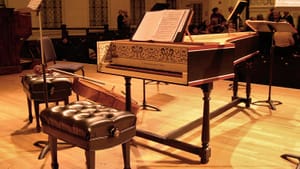Stay in the Loop
BSR publishes on a weekly schedule, with an email newsletter every Wednesday and Thursday morning. There’s no paywall, and subscribing is always free.
An event for the record books
Cellist Hai-Ye Ni conducts and plays with the Chamber Orchestra

The Chamber Orchestra of Philadelphia’s latest concert felt like a once-in-a-lifetime event. The guest soloist for the concert, Hai-Ye Ni, the principal cellist of the Philadelphia Orchestra, played five concertos and conducted the orchestra while she did it. How many times are you going to see that?
Four of the concertos were Baroque pieces, so they were shorter than the later works that form the core of the modern cello and orchestra repertoire. But the soloist was on stage, meeting peak demands, for the entire concert. She didn’t pack up her instrument and go home after one concerto, as soloists normally do.
As for the conducting — anyone who follows Baroque music has seen violinists and harpsichordists combine conducting and playing. It was a common practice in the Baroque period and persisted into the first part of the 19th century. But violinists and keyboard players are normally placed where the orchestra musicians can see them. Cello soloists face the audience, with their backs to the orchestra. The situation isn’t as bad as the plight of the kid in Woody Allen’s Take the Money and Run (who played the cello in a marching band), but it does have its drawbacks.
With a little help from her friends
Hai-Ye Ni dealt with this problem by transmitting her tempos and other instructions to the leader of the first violin section, concertmaster Miho Saegusa, who passed them on to the orchestra. Sometimes, in addition, Ni directly conducted the viola section on her left. She was also responsible, of course, for the all-important, behind-the-scenes shaping of the music that goes on during rehearsals.
For Ni, the concert racked up two firsts: This was her first attempt at conducting and the first time she had played Baroque music, even though she’s been pursuing a thriving solo career for over 20 years — in addition to serving as the associate principal cellist of the New York Philharmonic from 1999 to 2006 and the Philadelphia Orchestra principal since 2006.
There were a couple of places where the entrances weren’t as well-coordinated as they should have been, and the horns sounded too loud in the first movement of the Baroque concerto by Giuseppe Tartini. But her tempos and the general shape of the music all proved she understood the scores and possessed a conductor’s ability to draw a unified vision from the orchestra.
In spite of her unfamiliarity with the Baroque repertoire, she made good choices when she picked three of the 25 cello concertos Vivaldi wrote. Vivaldi’s critics have accused him of writing the same concerto over and over, but Ni’s selections were all noticeably different. The first displayed the exuberance we normally associate with Vivaldi, the second was heavier and more of a showcase for the cellist, and the third was a good example of Vivaldi’s obvious interest in exploring the possibilities of the solo instruments he wrote for.
Taking it slow
The three concertos all displayed a Vivaldian virtue that tends to be overlooked: Vivaldi wrote some of the most beautiful slow movements any composer has ever created. The passages in which Ni was accompanied by a harpsichord and one other cello produced some of the most magical moments of the afternoon.
A Baroque specialist might have handled the cello with a lighter touch, especially in the opening of the first Vivaldi. But the fuller “modern” sound of the cello didn’t clash with the lighter texture of the orchestra.
The Tartini concerto was a beautiful gem composed in the more measured French Baroque style. Tartini’s third movement Grave was a long autumnal aria, and the addition of two horns to the orchestra added to the elegiac quality of the other movements.
The Haydn concerto that ended the program moved the proceedings into an era with an entirely different style, one that Ni obviously felt completely at home with. In her remarks during the question-and-answer session that follows the Chamber Orchestra’s Sunday afternoon concerts, she noted that she had learned the concerto when she was 12. The climax is a series of challenging displays, one after the other, and she took all its hurdles like a champion, with no indication she was producing a flurry of action at the end of a marathon workout.
Hai-Ye Ni’s first teacher was her mother, who was a cellist in a Shanghai orchestra. Ni came to the United States when she was 13, and started attracting international attention in 1990, when she won first prize at a major cello competition at the age of 18. She decided to combine a solo career with an orchestral position, she has said, because she wanted a more settled life. Anyone who attended this concert should have left it with a headshaking appreciation of the talent concentrated in her position at the Philadelphia Orchestra. The concert promised a memorable experience, and its star delivered.
What, When, Where
Chamber Orchestra of Philadelphia: Vivaldi, Cello Concertos in E-flat major, A minor, and B minor. Tartini, Cello Concerto in D Major. Haydn, Cello Concerto in C Major. Hai-Ye Ni, cello and conductor. October 19, 2014 at Perelman Theater, Kimmel Center for the Performing Arts, Broad and Spruce Streets, Philadelphia. 215-545-5451 or www.chamberorchestra.org.
Sign up for our newsletter
All of the week's new articles, all in one place. Sign up for the free weekly BSR newsletters, and don't miss a conversation.
 Tom Purdom
Tom Purdom